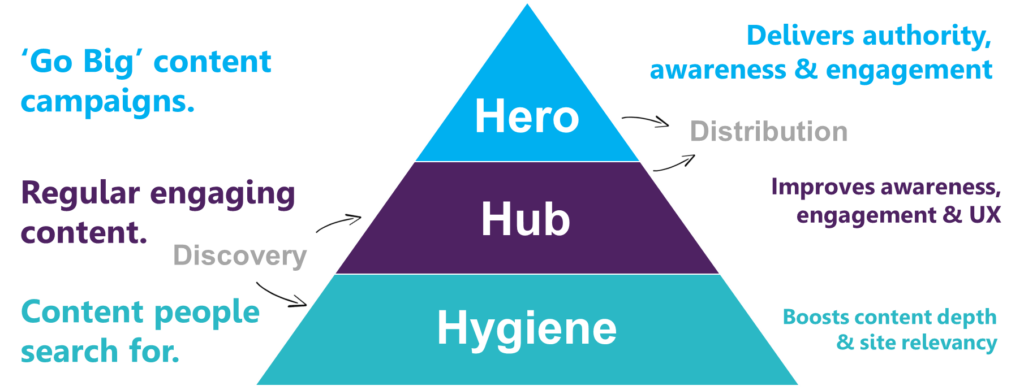In this month’s Brilliant Reads we discuss the elements behind an effective content strategy. A strong content strategy is comprised of many things – yet all are rooted in a single bedrock: data. For a successful campaign, it’s vital to combine data-led personas, SEO, the right topics and best content model.
Uniting SEO and content
For a content strategy to be successful, it’s essential to be data-driven and customer-focused. You need to use robust data to support content and ensure the customer is central. But when it comes to search optimisation – how integrated are your SEO and content teams?
There needs to be synergy between your search and content teams. Activity from both teams must ladder up to a combined strategy. We’ve pulled out our top highlights of how we achieved a truly united SEO and content team:
- Challenge each other and the brief: get an open dialogue going.
- Get a robust process in place: have regular catch ups, planning sessions and creative sessions.
- Get SEO and content people in every conversation: get all views and make sure everyone is included.
- Let SEO and content equally inform each other: be prepared to adapt and adjust content.
- Make sure the content creation process is iterative: content goes between SEO and content teams to hone and tweak.
- Never create a page and leave it alone: content needs constant nurturing to perform at its best. Put in regular reviews to monitor and refresh content if needed.
With these methods, your teams can thrive together instead of languishing alone.
Why you should unite your content and SEO team – Brilliant Noise – 3mins
Always have your personas in mind
With more data generated in the last two years than in the previous 20,000 combined, it’s essential for marketers to use data-driven personas to supercharge their strategy, content and campaigns. By using tools such as web analytics, social listening platforms and digital surveys; we can create fast and scalable insights. It’s not about waiting for months for survey data – you can adjust parameters in each tool when you spot new insights. That means you can answer questions like:
- What are our personas talking about right now?
- Where are our personas posting content online?
The answers to these questions can provide useful insights for strategists to plan, creatives to create, and publishers to produce brilliant content. By using data-driven personas you gain invaluable, in-depth knowledge to strengthen your marketing.
The dream of data-driven personas – Brilliant Noise – 4 mins
Don’t underestimate the power of influencers
You may have seen all the negativity and badly executed influencer campaigns out there. This is why it’s easy to assume that influencer marketing is just another trend that will be forgetting before long. However, influencer marketing is important. Why? Because the way people shop and make decisions about purchases have changed. Customer touch points, customer journeys and the technology used to make decisions have changed. People trust recommendations from peers over your company’s website or Google.
Here at Brilliant Noise, we champion advocacy not endorsement. We find people who love your brand and are interested in what you’re doing. We help you build a better connection between your customers and your brand.
Our recent influencer strategy and campaign is evidence of this. We centrally manage and design content campaigns with influencers based on their strongest channels, what kind of content works well for them and what their audience engages with. Now for the first time, EDF Energy has an influencer strategy to create social proof, raise brand awareness and support their content strategy.
Our lead programme for 2019 is the Electric Adventures campaign. This is an influencer-led, six-part web-series about UK road trips in electric cars. You can see the latest episode below:

Influencers: three reasons why they’re as important as ever – Brilliant Noise – 4 mins
Building a structure with the Hero, Hub, Hygiene model
When people think about creating a content programme, it’s often under the label of content marketing, or social media marketing. But that’s just the tip of the iceberg: the most visible part of something much bigger. People need content at every stage of their relationship with a brand – content marketing is only the solution for a few of them.
Content production can be broken down into four main categories:
- UX copywriting or microcopy: content that sits within the IA, processes, tools, or e-commerce parts of your website e.g. menu labels, help text, form labels etc.
- Evergreen content: ‘hygiene’ content, which is always relevant to your audience e.g. how-tos, customer service, product information.
- Campaign: ‘hero’ content, which is published at key moments and has a short life-span, e.g. product launches, ‘tent pole’ events.
- Always-on: ‘hub’ content which is published on a daily basis to give a fresh, seasonal, or relevant perspective e.g. seasonal promotions, reactive content, curated content.
Most content marketing is a hybrid of campaign and always-on. Focusing on content marketing alone ignores UX and evergreen content. These types of content have a huge role to play in your overall customer experience.

To facilitate strong content production you will need to think about:
- User research
- Planning
- Creation
- Distribution
- Analysis
- Optimisation
Producing consistent, customer-focused content is not easy – but done well it’s the difference between a functional brand and one that delights and inspires its customers.
The why, how and what of content: thinking beyond production – Brilliant Noise – 3 mins
The power of storytelling
Storytelling is an essential part of compelling brand content. Sometimes you’ll have things to say that don’t fit on your social channels or company website. You might have an exciting new partnership you want to tell everyone about, a new product launch or a social cause you’re supporting. Storytelling content can raise greater awareness and engagement for your new offering than social and site updates.
When creating branded stories, you should consider what you have the right to say. Stories need to be relevant to your product, service or brand in order to be authentic. Think about a theme, value or idea you want to champion or question.
When you have a theme, you can decide how you want your audience to feel when they’re engaging with your story. Do you want them to be convinced of an idea? Do you want them to donate to charity? Buy a product?
The power of storytelling is being able to create a feeling of empathy in your audience. You get the opportunity to persuade and make people act or think differently towards your brand.
Stories give brands a chance to show what they stand for in new and creative ways.
Telling compelling brand stories – Brilliant Noise – 4 mins
Enter your email below to sign up for more of our latest content or get in touch here if you’d like to speak to us about effective content strategy.
[hubspot type=form portal=5554216 id=df2ee318-4743-440e-affe-dd29663432b5]
